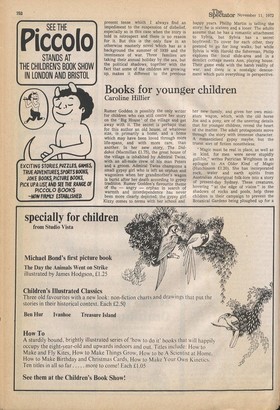Books for younger children
Caroline Hillier
Rumer Godden is possibly the only writer for children who can still centre her story on the 'Big House' of the village and get away with it. The secret is perhaps that for •this author an old house, of whatever size, is primarily a home, and a home which may have been loved through more life-spans, and with more care, than another. In her new story, The Diddahoi (Macmillan £1.75), the great house of the village is inhabited by Admiral Twiss, with an all-male crew of his man Peters and a groom. Admiral Twiss champions a small gypsy girl who is left an orphan and wagonless when her grandmother's wagon is burnt after her death according to gypsy tradition. Rumer Godden's favourite theme of the — angry — orphan in search of warmth and interdependence has never been more clearly depicted; the gypsy girl Kizzy comes to terms with her school and her new family, and given her own miniature wagon, which, with the old horse Joe and a pony, are of the unerring details that for younger children, reveal the heart of the matter. The adult protagonists move through the story with immense character. A romanticised gypsy maybe, but the truest sort of fiction nonetheless.
"Magic must be real in place, as well as in kind, for men were never stupidly gullible," writes Patrician Wrightson in an epilogue to An Older Kind of Magic (Hutchinson £1.20). She has incorporated rock, water and earth spirits from Australian Aboriginal folk-lore into a story of present-day Sydney. These creatures, hovering "at the edge of vision" in the shadows of rocks and pools, help three children in their campaign to prevent the Botanical Gardens being ploughed up for a car-park. They are also abetted by a determined advertising copywriter, Ernest Hawke, who feels this cause has more to offer him than creating jingles such as "Follow your hunch; try Crackle-Crunch.” The magic is entirely convincing; the book full of good dialogue and humour. It is striking that, in a book about preservation, the city is made to appear beautiful, only ' commerce ' rapacious. The bridge, reflections in dark water, steel and concrete mountains, cliffs of lights, are as much essential of the place as the underground spirits.
Helen Cresswell's The Beachcombers (Faber £1.30) contains less magic and fantasy than some of her books but seems to me all the more successful. A schoolboy, Ned, goes as a seaside holiday lodger to stay with the Pickerings, a very nasty family indeed (or are they so nasty?), who live in a basement and scrounge scrap for a living. They are for ever rubbing their hands and saying "0 fancy" and "in a minute, dear ", and offering him nice cups of tea and soaked peas. Luckily he meets the Dallakers down on the beach — strange, wild cousins of the Pickerings, who live on a flat-bottomed schooner stranded on the sand. The Dallakers are scavenging for a more real treasure (or is it more real?), the old ship's log lost at sea with other valuables in a brass-hound chest. Ned is confused, torn between the two ways of life, but he can't resist the spell of the Dallakers. "Come with us when we sail," Fiony Dallaker says to him. The book ends here. The author's afterword (and a foreword in which she finds the actual manuscript of this book in a glass bottle) seems more contrived than necessary after this brilliant and subtle allegory, but it allows her to explain that she does not know if Ned stayed or went, "but how could he have stayed?" and that she does not know what she would have done in his position. Her dilemma as a writer? (Is this for children?) But this is only one of many possible interpretations of a very human and lively book.
The Thirteen Days of Christmas by Jenny Overton (Faber £1.70), in incorporating into its narrative the text of several old carols from The Oxford Book of Carols and from sources based on Francis James Child's collection, sheds a clear Christmas light on the traditional songs. It is a funny and unsentimental, but romantic story of how an unimaginative lover turned this coat and wooed his bride with a bevy of partridges in miniature pear trees, gold rings for all the curtains in the house and enough swans a-swimming and ladies dancing to clutter up the streets and cause an assenting blush on the girl's cheek. Occasionally, aspects of the seventeenth-century setting seem anachronistic, but the story never becomes predictable because the author has cleverly added other presents to the list in the carol — ribbons and wine and water-lilies and corn for all those birds and muslin bags so that the maids a-milking can make cream cheese. An ' original and cleverly sustained tour de force.
Tales Told to Kabbath Aboriginal legends Collected by Daisy Bates, retold uy Barbara Ker Wilson (Angus and Robertson £1.50).



















































 Previous page
Previous page